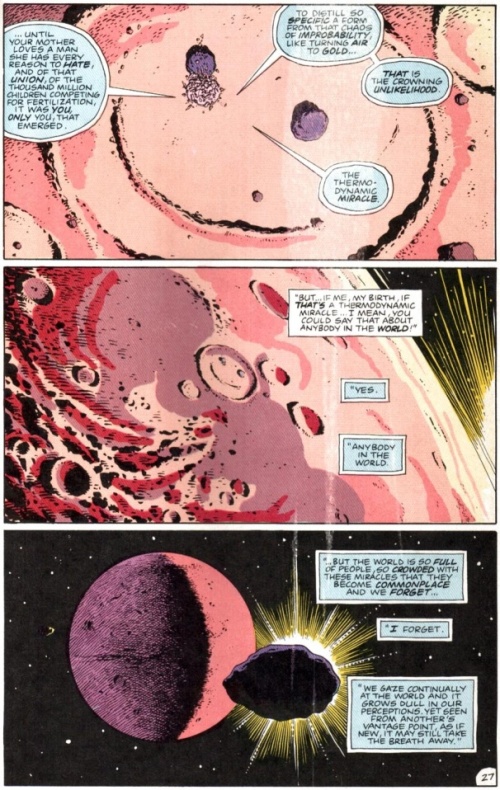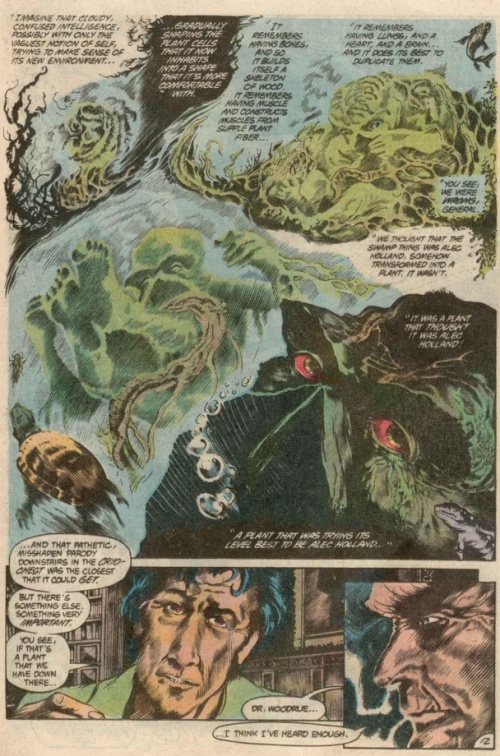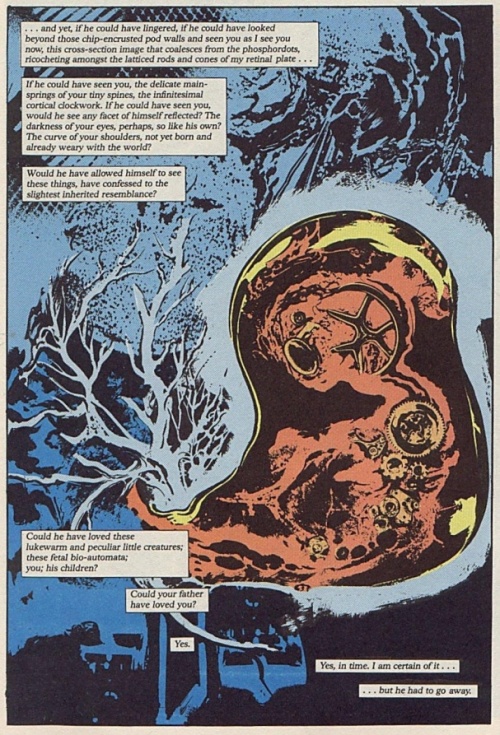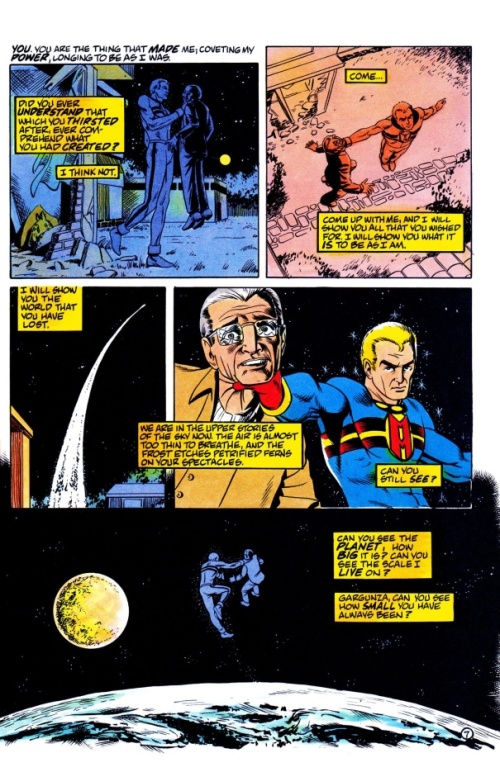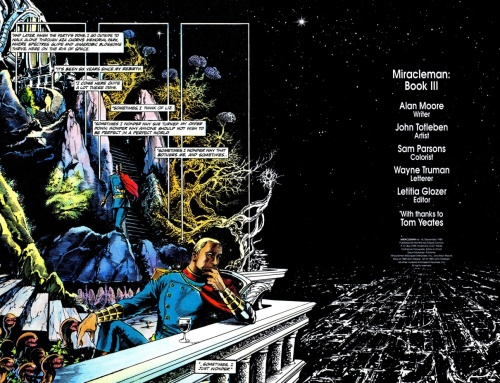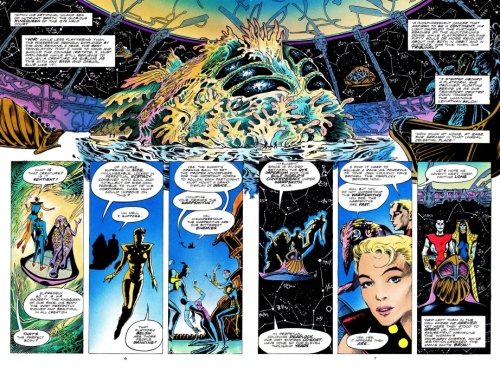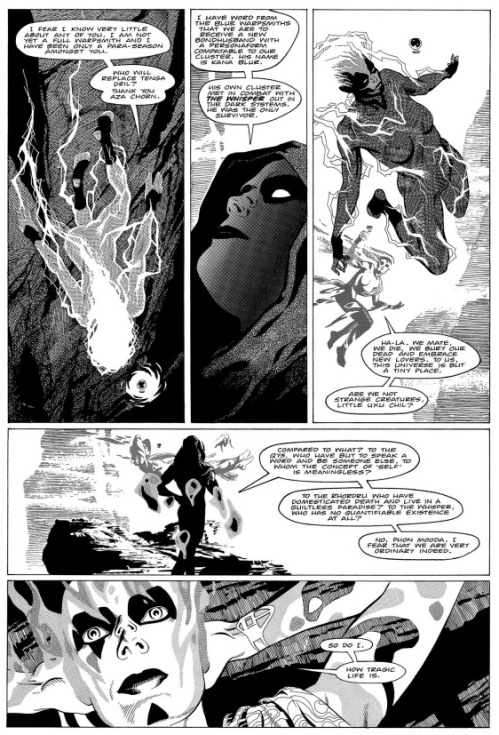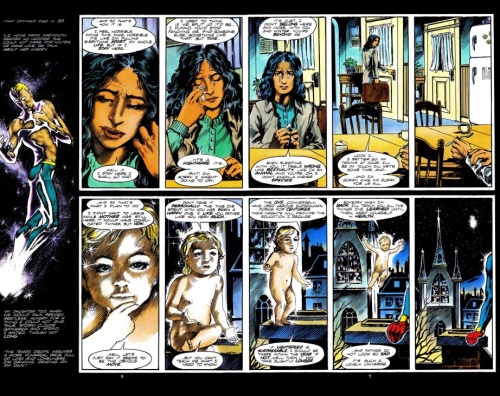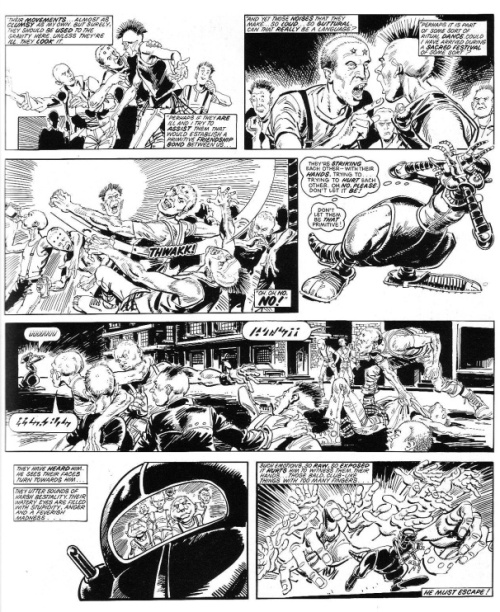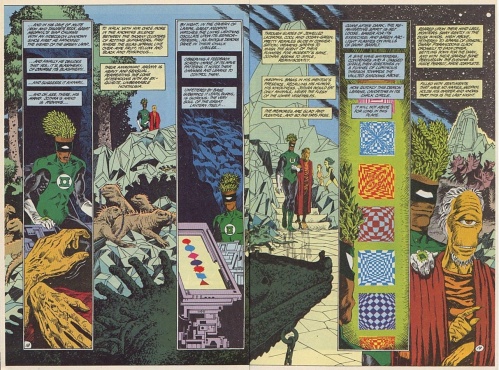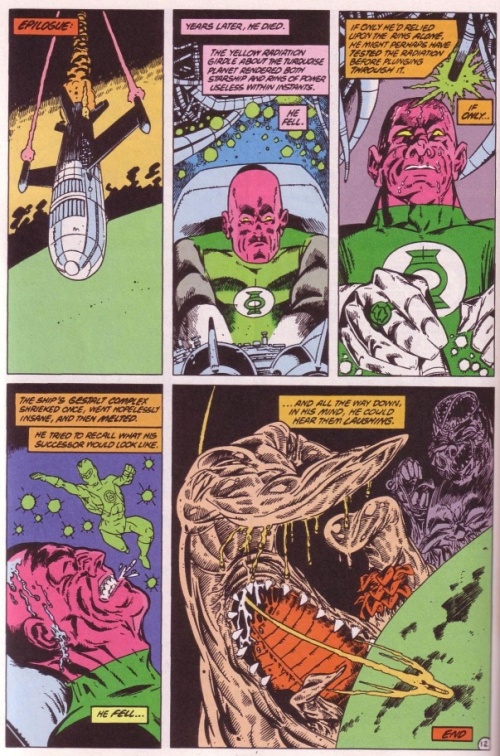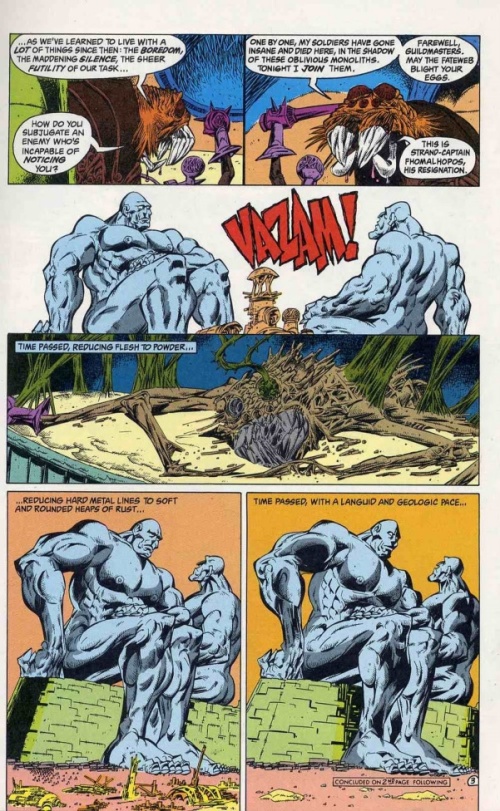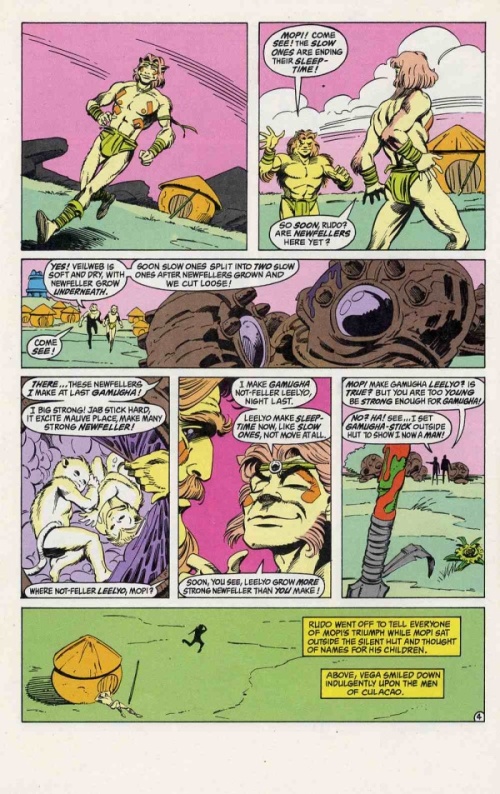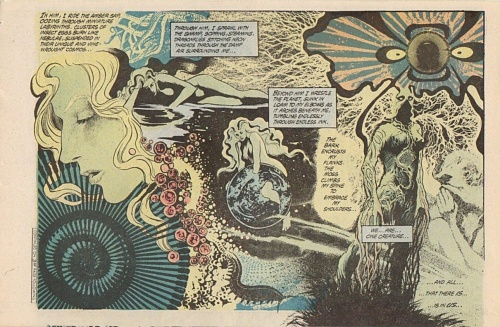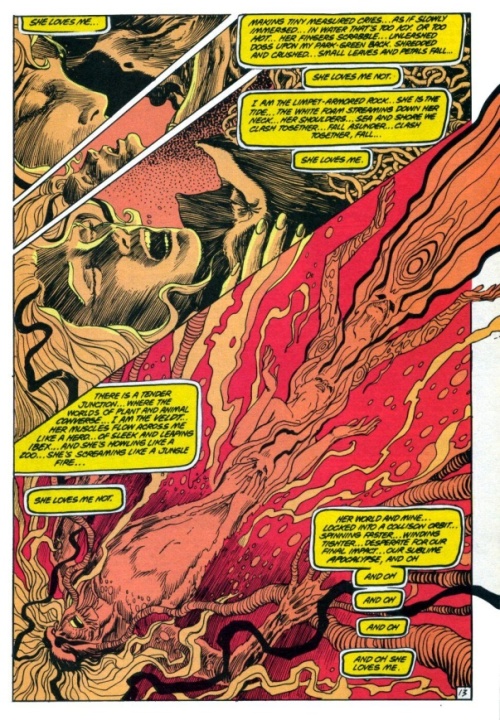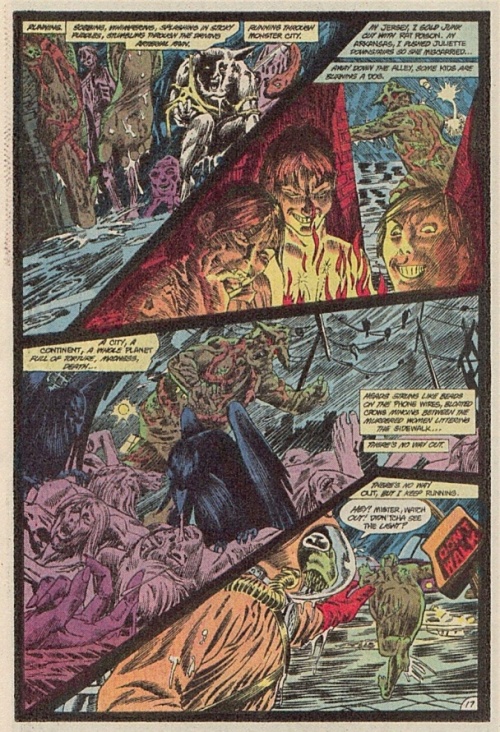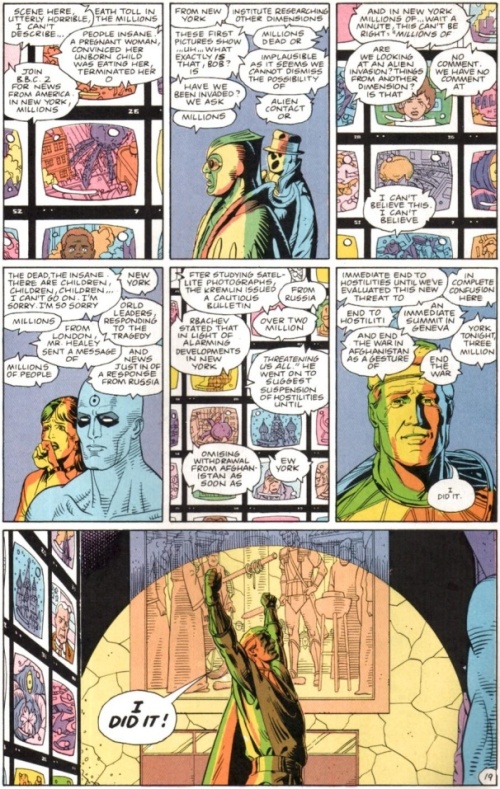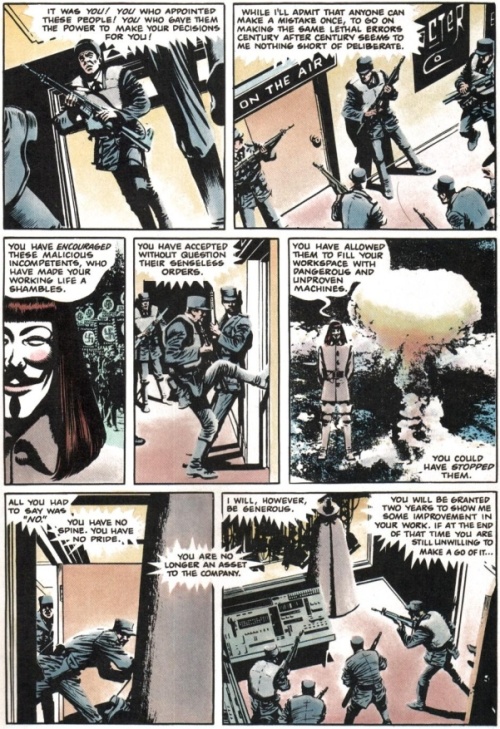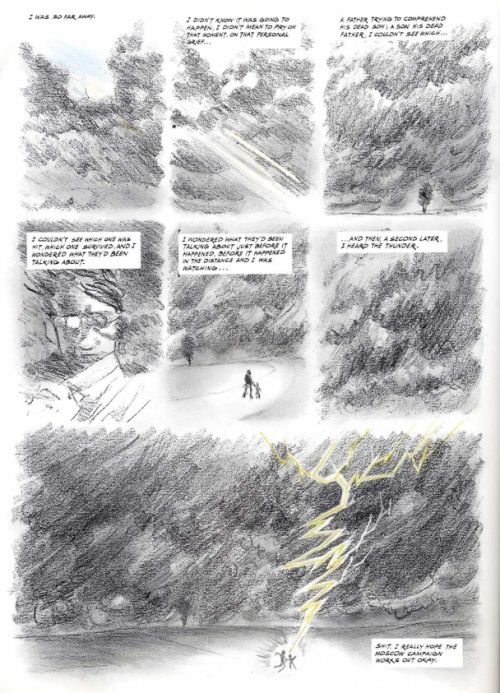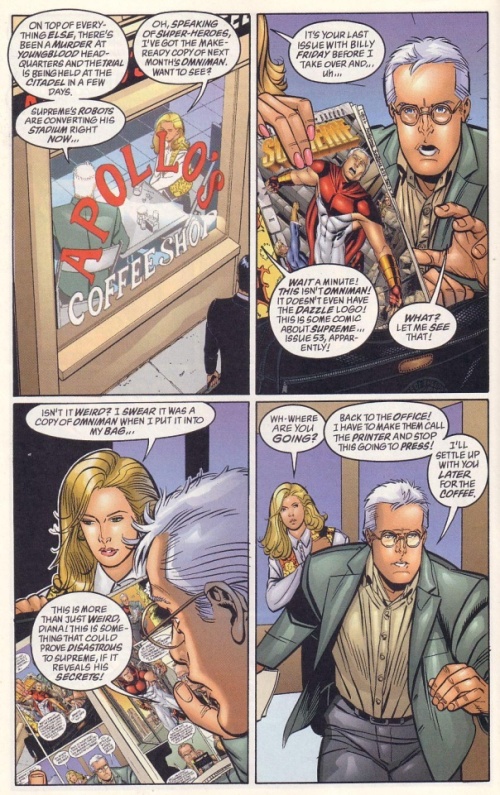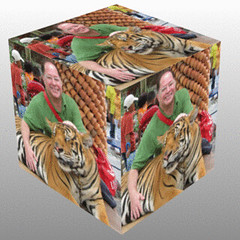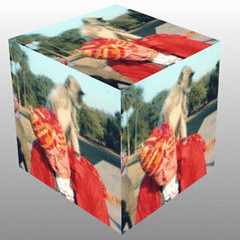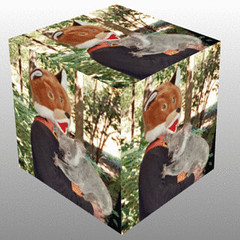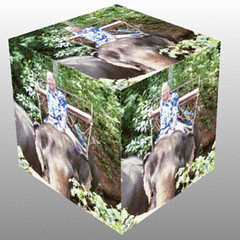Alan Moore is one of the top comic book writers of all time. Alan Moore uses many specialized techniques to entertain the reader including superhero universe reboots but another technique he uses to make his stories especially engrossing is the novel use of point of view (POV) in his narrative. Moore uses alien POV, hallucinogenic POV, intelligent ethically ambiguous POV, stream of consciousness POV, and a story within a story POV in order to make his fiction more interesting.
Alien POV
Doctor Manhattan is Superman type character in the series Watchmen. Doctor Manhattan has the ability to see the past, present and the future at the same time. This is vision (time) or 482 in my foxhugh superpower list. Doctor Manhattan may have been human at one point but due to an accident became a being that is growing distant from humanity. Ozymandias on Doctor Manhattan, “If there’s one thing in this cosmos that that man isn’t capable of doing it’s having a political bias. Believe me… you have to meet him to understand. I mean, which do you prefer, red ants or black ants?” Doctor Manhattan can also make multiple versions of himself and does this for practical purposes but also because this is a point of view that he finds interesting. Doctor Manhattan can perceive subatomic particles that exist for nanoseconds. Doctor Manhattan has developed a nihilistic view of reality due to his superhuman perceptions that is shared by very few human beings but The Comedian is one of them (see Figure 1 below).
Doctor Manhattan is so removed from the human POV that he almost does not intervene to save the world from WW III (see Figure 2)!below
And true love does not change his mind but instead he has some sort of eureka experience related to human individuality relative to probability (see Figure 3 below) and this insight causes him to try to stop WW III.
The Swamp Thing discovers in Swamp Thing, v2, #21, the first issue of this character that Alan Moore wrote, that he is actually a plant not a human and this knowledge causes him to change how he views humanity and temporarily flip out and commit his first murder. Alan Moore decides to turn a superhero that was a man with plant features into a plant period with a plant POV! This story is aptly titled “The Anatomy Lesson” and is a POV driven plot (see Figure 4 below).
Alan Moore decided a superhero even more removed from humanity would be more interesting. The Swamp Thing can also perceive and move through “The Green” which is some sort of dimension that contains the consciousness of all plant life. As a plant and later an elemental, the Swamp Thing sees the human struggle between good and evil in a larger transhuman context. Humans are one of many species and the welfare of humans at the expense of the environment is not acceptable.
In a two issue story arc, the story is told from the POV of an alien that happens to be an Earthling! In “Mysteries in Space”, Swamp Thing, v2, #57 and “Exiles” Swamp Thing, v2, #58, Adam Strange is the hero of planet Rann. The inhabitants are more advanced than Earthlings and have difficulty doing “primitive” things like fighting and procreating. Adam Strange has slowly become aware that the Rannians see him as an ape-man errand boy and the statute erected in his honor as the hero of Rann is a façade to flatter him into doing their bidding. There is plenty of action in the story but Adam Strange’s internal dialogue about he is perceived in the Rannians is actually more interesting. In the end his relatively, to Earthlings, Rannian girlfriend, Alanna Strange, is found to be pregnant and this is the first pregnancy in quite some time on Rann. The Earthling “alien” has done the “job” he was probably recruited and manipulated for in the first place (see Figure 5 below)!
Another story of Swamp Thing tells the story totally from the point of view of an alien! In “Loving the Alien”, Swamp Thing, v2, #60, an alien that is a planet made of biomechanical material is telling the story of her courtship of the Swamp Thing. I guess alien biomechanical planets have a hard time finding suitable mates and all prior attempts at failed and often caused the death of the potential mate. Swamp Thing tried to escape but she used a “chronofracture” which reverses time to get a second chance at catching the Swamp Thing and she has her way with him. She transfers all the information biological and otherwise into her reproductive system and voila little baby aliens that want to hear the story of their mothers courtship and mom wonders if dad would love his children if he had gotten to know them (see Figure 6 below)!
Miracleman is another Superman type character radically rebooted by Alan Moore who reflects on his superhuman condition has changed how he views the world. Even his “father” who is a genius by human standards cannot understand the perspective of Miracleman in the opinion of Miracleman (see Figure 7 below).
Miracleman’s perceptions evolve and he recognizes his superhuman condition probably distances him from humanity and he sees this as a negative (see Figure 8 below).
The Miracleman’s universe includes two alien empires including the Qys and the Warpsmiths. The Qys can change bodies the way we change clothes and this radically changes their sense of self. This ability changes the aesthetic of the Qys so radically that they are ruled by what to a human would seem like a giant monster (see Figure 9 below).
The Warpsmiths have the power of teleportation and with this power also perceive time very differently than humans. There are hints that this power changes how they perceive the universe and their role in the universe (See Figure 10 below).
For Alan Moore, superpowers are not just tools for fighting crime but create sensibilities that change POV radically. The daughter of Miracleman realizes that Miracleman’s perspective is too human for her growth and development as a superhuman and leaves her father to go live with the Qys despite being a newborn (see Figure 11 below).
Skizz is a character that Alan Moore created for 2000 AD. Skizz resembles an E.T. the movie sort of alien and one biker actually refers to Skizz as being like E.T. in the movie. Skizz is an interpreter and not very formidable physically and we get to see Earth from the point of view of an alien that finds us barbaric (see Figure 12 below).
More than any other comic book that I am familiar with, the story of Skizz revolves around the POV of an alien rather than relying on action for plot delivery.
In Swamp Thing v2, #32, “Pog”, Alan Moore treats us to an alien that in a manner similar to Skizz provides an alien point of view in which we are seen as barbarian but even more than that a savage planet. On the planet of Pog, even different species of animals coexist but in our planet a cartoonish crocodile will be eaten real crocodiles (see Figure 13 below).
There is a metafictional aspect to Pog since Moore is comparing two types of comic book universe not just aliens and Earthlings. The comic strip Pogo universe of Walt Kelly is being compared with the grittier Vertigo universe that Swamp Thing inhabits.
In Swamp Thing v2, #61, “All Flesh is Grass”, Swamp Thing meets a Green Lantern (Medphyll) on his alien home world in which plant life is sentient. The title “All Flesh is Grass” is from the Bible and refers to the transitory nature of existence. The story is told from the POV of Medphyll and the reader is treated to a description of an alien world of sentient plants and the art, religion and plant based architecture of the planet are described in detail. The Green Lantern oath reflects the plant POV of the ring bearer:
“In forest dark or glade beferned,
No blade of grass shall go unturned.
Let those that have the daylight spurned,
Tread not where this green lamp has burned.”
The Swamp Thing is the horror from the stars in this story and we are reminded that what is a hero or a monster is a matter of perspective. The Swamp Thing inhabits the form of Medphyll’s deceased and beloved teacher Jothra and the Swamp Thing and the reader are given a tour of this very interesting planet (See figure 14 below).
Aliens like Dr. Manhattan, the Swamp Thing, Miracleman, Skizz and Pog view the world in a radically different way that in turn change how they think. Super powers do not just let the character smash mountains but change how the characters perceive mountains and this is actually often more interesting.
Alan Moore wrote three stories about the Green Lantern Corps for DC Comics. In the story “In Blackest Story”, Tales of the Green Lantern Corps Annual #3 (1987), the Green Lantern Katma Tui has a very difficult time explaining the whole concept of the bright light of Green Lanterns fighting darkness because the alien, Rot Lop Fan, Katman Tui is talking to cannot see and has no concept of light (see Figure 15 below).
In “Mogo Doesn’t Socialize”, Green Lantern, v2, #188, the bad guy cannot find the Green Lantern until he realizes the Green Lantern Mogo is not an inhabitant of the planet but the planet itself (see Figure 16 below)!
In “Tygers”, Tales of the Green Lantern Corps Annual #2 (1986), a hyper rational Green Lantern, Abin Sur, fails to understand how a demon of the Empire of Tears, Qull of the Five Inversions, can use his perceptual abilities that combine clairvoyance, cunning and an understanding of mortal psychological weaknesses in order to create a death trap with words alone. Abin Sur feels protected by his scientific world view but in fact the supremely evil POV of the demon allows the demon to murder Abin Sur even though the demon is imprisoned and should be helpless (see Figure 17 below).
In all three Green Lantern Corps stories, there are two aliens that have such radically different states of being that their POV makes mutual understanding difficult. The Green Lantern Corps are aliens. Moore realized the rich potential in exploring the alien side of the Green Lantern Corps rather than treating them like Earth based super humans that happen to look funny due to a third eye or some other cosmetic difference between the alien and us. The Green Lantern Corps stories are even more POV centric than the other superhero stories mentioned previously.
Alan Moore develops the Alien POV idea even further in the Omega Men series. The Omega Men are a team of extraterrestrial superheroes in a solar system other than that of Earth called the Vegan system. Alan Moore did two back stories for the series that take place in the Vegan system but do not involve the Omega Men directly. In “Brief Lives”, Omega Men #26, the Spider Guild, giant intelligent spiders, try to conquer giant aliens in the planet Ogyptu that live for millennia and move, think and perceive the world at a glacial pace, literally. The entire invasion by the Spider Guild over a thirty year period is barely perceived by the giants. The invasion fails because the POV of the giants is so radically different than that of the Spider Guild that the invasion cannot even be perceived and therefore cannot be successful (see figure 18 below).
In “A Man’s World”, Omega Men #27, a female xenobiologist, or possibly an anthropologist since she mentions the rules of inter-system anthropology, studies a tribe called the Culacaons that reproduce minus women. The female alien named Leelyo pays the ultimate price for not understanding the POV of the males in the tribe. After probably three rereads, the reader figures out that the males of the Culacaons stab giant snails and plant their babies into the giant snails. The reader can infer that the Culcaon male stabs
poor Leelyo and probably deposits the children in her body after stabbing with
her with his Gamugha stick. Apparently, the male tribesman sees the female alien not as a fellow humanoid but as more similar to the giant snails and deserving similar treatment. From the POV of the male Culacaon Leelyo is more like the giant snails than like him! This story is widely dismissed as a very poor story. However, if you reread the story then the horrible truth of the story becomes apparent and the true meaning of the title, “A Man’s World” becomes horrifyingly apparent (see Figure 19 below)!
Hallucinogenic POV
Swamp Thing was radically changed during his tenure under Alan Moore. The Alan Moore Swamp Thing has tubers growing from his body that more or less has the same effects as peyote. In “Rite of Spring”, Swamp Thing v2, #34, the Swamp Thing gives his girlfriend Abby Arcane a tuber in order to educate her about his perception of the Earth via The Green (see Figure 20 below).
In “The Return of the Good Gumbo”, Swamp Thing v2, #64, the Swamp Thing again gives his soon to be wife Abby Arcane a tuber to eat since nothing says love like hallucinogenic tubers. Abby is literally eating a part of her lover and has hallucinations that help her understand how the Swamp Thing perceives the world and they also have really good sex (see Figure 21 below)!
In “Windfall”, Swamp Thing v2, # 43 a hippie named Chester found a tuber lying around the swamp and brought it to Baton Rouge. Pieces of the tuber end up in a woman named Sandy painfully dying of cancer and she hallucinates a luminous body free of pain and is transported to a radiant heaven like garden in which she dies in the arms of her husband (see Figure 22 below).
A sleazy drug pusher named Milo has a really bad trip and hallucinates some of the very ugly and evil villains the Swamp Thing has encountered. The tubers as parts of the Swamp Thing apparently contain the memories of the Swamp Thing at some level (see Figure 23 below).
When Chester finds out what happened to Sandy and Milo he theorizes that the tubers bring out what is in your as a person. Good people have good trips. Bad people have bad trips. Chester ponders whether or not to take what is left of the tuber and decides not to.
In V is for Vendetta, the lead detective, Eric Finch takes LSD at the shut down concentration camp Larkhill. The psychedelic imagery used is disturbing and unnerves the reader. Finch hallucinates the naked torsos of a man and a woman perched on barbed wire (see Figure 24 below).
Finch hallucinates wearing the striped garb of a prisoner. Finch has a hallucination about a crowd of black people, presumably killed at the camp and they are friendly towards him but ultimately move away from him and disappear into a wall. Finch is then transported in to his middle class house but this is also a hallucination. Finally, Finch takes off all his clothes and experiences freedom from social constraints in the center of Stonehenge. Stonehenge may or may not be a hallucination. Eric Finch is using the LSD experience to help him understand how V thinks and to some extent succeeds. V is an anarchist and Finch does develop an understanding of freedom that helps him in turn understand V.
In DC Comics Presents #85: “Superman/Swamp Thing: The Jungle Line”. Superman is hallucinating due to an infection by a Kryptonian fungus and has flash backs about Krypton that reveal a great deal to the reader about how Superman handles his Kryptonian heritage. Swamp Thing is perceived as an enemy due to the hallucinations and is almost destroyed. Some of the more interesting hallucinations Superman has are talking with his empty Clark Kent clothes and the empty suit explains to Superman that he is dying and furthermore that he is nothing special. Superman seems to suffer from Survivor guilt which manifests in his hallucinations (see Figure 25 below).
Swamp Thing can enter the hallucinatory world of Superman because this world is in part generated by a “plant”, strictly speaking a fungus is not a plant, and the Swamp Thing takes Superman into “The Green” which breaks contact with the scarlet jungle of the fungus Superman was dying in. In this plant dimension the Swamp Thing soothes Superman so he can sleep and this allows Superman to recover.
Alan Moore returns to the use of a hallucinogenic plant as a central plot device a third time in “For the Man Who Has Everything”, Superman Annual #11. This is of course the second time Moore has Superman hallucinating due to a “plant” (see figure 26 below).
A large alien plant called the Black Mercy has Superman trapped in a coherent hallucinated world on the planet Krypton and this is supposed to be his deepest desire. This is the Krypton that would have happened if Krypton had not blown up. Superman has never been Superman and has a Kryptonian brother and a niece. This alternate world is supposed to be what the person really wants but soon turns ugly due to Kryptonian xenophobia and presumably this is the unconscious of Superman trying to free himself from the grip of the Black Mercy. Batman also ends up with the plant on his chest and in his hallucination he is in a world in which his parents were not killed. Finally, the bad guy, Mongul, ends up with the plant on his chest due to Robin. Mongol has a hallucination of a world of endless conquest and Superman’s head on a pike.
In all the stories examined, the person hallucinating does gain insight that is often helpful. The hallucinations are not always pleasant but generally reveal truths rather than being random and meaningless.
Intelligent Ethically Ambiguous POV
Generally in comic books the hero is simplistically good and the villain is simplistically bad. Alan Moore departs from this practice and presents antiheros. Comic books have any number of muscular tough guy antiheros like The Punisher and Wolverine but generally ruthless intelligent characters are invariably super villains. Alan Moore uses intelligent antiheroes that present a compelling argument for ruthless action.
Ozymandias is a major character in Moore series Watchmen. Ozymandias is considered the smartest man in the world. This very intelligence forces him to see the world differently than his fellow superheroes that are not as intelligent. Ozymandias is at the upper limits of human intelligence but probably does not possess super intelligence. The only Watchmen superhero to really agree with the actions of Ozymandias to save the world is Dr. Manhattan who probably possesses out and out super intelligence. Ozymandias manages to save the world from WW III but kills millions in New York do accomplish this task. The reader is allowed to share the triumph of Ozymandias directly and the background picture of Alexander the Great cutting the Gordian Knot is intentional (See Figure 27 below).
V in V is for Vendetta is an antihero and is a powerful fighter but what makes him really dangerous is his super intelligence. V uses strategy to take apart the fascist party Norsefire that rules Great Britain. V commits various acts that may be considered unethical. V kills a Bishop, Anthony Lilliman. However, the bishop is also a pedophile so that’s probably ok. V kills a doctor, Delia Surredige. Dr. Surredige has clearly repented for her sins in the concentration camp V was in. Killing a woman is generally not done by heroes. Killing someone who has reformed is also not generally done by comic book characters. V also kills the hired help of Norsefire that happens to be in the way. V doesn’t do comic book things like use stun guns, non lethal Karate chops, or shoot their pistols out of the hands of henchmen. Generally V throws knives into the hearts of the henchmen. Killing the hired help is something the Punisher and Wolverine also do so this is not new ground for a comic book antihero. V does imprison and torture Evey, a girl he had saved previously, and even used as a side kick. Evey is clearly an innocent. V tortures her to set her free by toughening her up! V does provide the reader with a very eloquent defense of his actions (See Figure 28 below).
V and Ozymandias are intelligent men that employ ruthless means to accomplish noble ends and we are privy to their thought processes which generally is the POV of a super villain like Doctor Doom not a hero and this use of POV forces the reader to go beyond the simple structures of good and evil normally associated with comic books even comic books with antiheros.
Stream of Consciousness POV
Comic book writers did not employ stream of consciousness in early comic books. The use of stream of consciousness is a narrative technique that is employed more and more in comic books in the present. Alan Moore makes extreme use of an interior monologue in all of his comic books. Rorschach’s internal monologue is used extensively in Watchmen. However, Alan Moore pushes the comic book envelope of stream of consciousness in A Small Killing.
Alan Moore has used a stream of consciousness POV exclusively in A Small Killing and the narrative the use of images from the inner world of the protagonist. There is very little action in A Small Killing and we follow the protagonist as he is haunted by a ghost like child that is presumably a hallucination of himself as a child. However, there is a hint that the child might be an actual ghost rather than a hallucination (see Figure 29 below).
Incredibly I didn’t care about the nature of the child because the protagonist is an unlikeable whiner and I am sad that the “ghost” child did not succeed in killing the protagonist. A slow read that is POV technique driven to the point that reading pleasure is sacrificed for art. The favorite device for exploring stream of consciousness for Moore seems to be via the use of hallucinogens by the characters in his stories which is already discussed in detail in the prior section of this essay.
Story within a Story POV
Alan Moore often employs the metafictional device of a story within a story in order to give his narrative added depth and complexity. In Watchmen, one of the children is reading a comic book about pirates called the Tales of the Black Freighter and the bleakness of the story makes the already “real” story of the Watchmen even more nihilistic and acts a plot juxtaposition device.
Miracleman was programmed in a reality that resembled a superhero comic book. The adventures of the Miracleman family in this virtual reality can in turn be self contained stories. There was a Marvelman comic book published in Great Britain in the fifties and from the perspective of the Moore series, those adventures took place in a virtual reality which explains the lack of “reality” in those adventures. Miracleman is also a comic book fan and comic books are part of the narrative but this device was exploited more by other writers after Moore such as Neil Gaiman in Miracleman: Apocrypha.
Alan Moore’s Supreme has many metafictional layers but I will stick to the story within a story elements. In the Supreme comic book, Moore’s Supreme has the secret identity of Ethan Crane who works Dazzle Comics on a character named Omniman that is being rebooted. In reality, Supreme is a Superman character that is being rebooted by Alan Moore. The comic book within a comic book is a parallel story! Eventually Supreme even has a fight with his own comic book creation in Supreme #53. Supreme becomes a character in a comic book that fights Omniman (see Figure 30 below) but of course there is a “logical” explanation and a Szazs, a Mister Mxyzptlk, clone, is the cause.
In The League of Extraordinary Gentlemen, Moore creates an entire universe made up of fictional characters from novels. This is not exactly a story within a story device but is a metafictional device. Basically Moore’s League invention is a pastiche of prior stories!
Conclusion
Alan Moore uses certain novel POV techniques with different characters in different comic book series in order to consistently make his stories more interesting. There is a synergistic effect created by using so many POV techniques within a single narrative. The combination of POV techniques causes the reader to feel transported to an unnerving and alien reality and upon reflection the cause of this feeling is hard to pin point but I would argue the POV techniques are a major cause. POV drives plot in many instances. How the character perceives reality not only explains the behavior of the character but often acts as the deus ex machina of an Alan Moore story. The character must behave a certain way because of their perceptions.
Alan Moore uses caption boxes instead of thought bubbles to show the thoughts of the character. This allows for lot more information to be expressed. Alan Moore uses a lot of caption boxes relative to speech bubbles compared to other writers and this shows that POV is more important to Alan Moore than other writers.
Many of Alan Moore’s comic books have been made into movies including some discussed here (Watchmen, V is for Vendetta). The art and text attempting to show the POV of Dr. Manhattan is one of the high points of this series that was not really explored in the movie and this lack of the comic book POV devices made the movie less interesting in many ways than the comic book series the film was derived from.
Document at:
You can also download my autobiography of my struggle with a bipolar condition on Am I Kitsune on my Google Drive.
WereVerse Universe Baby!
WereVerse Universe at Google Drive Link




